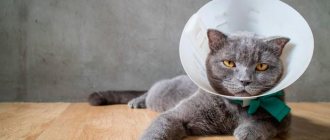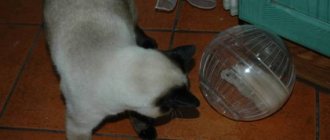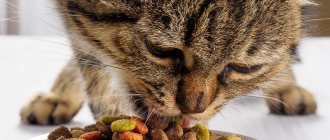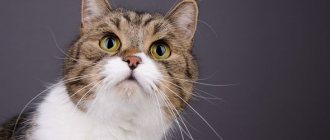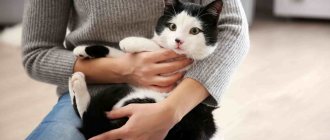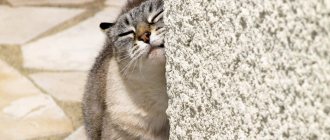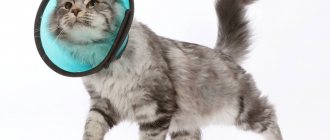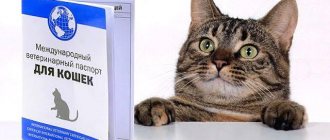What it is
The collar is made in the form of a cone, the brim of which serves as a barrier around the animal's head. It is also called veterinary or “Elizabethan”; such products were in fashion during the reign of Queen Elizabeth of England. They came up with the idea of using similar ones for animals in the 60s of the last century, putting them around the neck and thus protecting the pet during illness.
Ready-made collars are sold in veterinary pharmacies and pet stores. The price depends on the material: plastic 100 rubles, inflatable up to 800, branded ones are more expensive. You need to choose a design in accordance with the dimensions of the pet.
How to choose a ready-made veterinary collar
Protective cones for cats are standardized in terms of dimensions; a total of 7 sizes are available.
Size chart of protective collars for cats - table
| Marking | Neck circumference (cm) | Collar height (cm) |
| № 7 | 22–25 | 7 |
| № 10 | 22–25 | 10 |
| № 12 | 28–33 | 12 |
| № 15 | 31–38 | 15 |
| № 20 | 38–44 | 20 |
| № 25 | 44–50 | 25 |
| № 30 | 47–57 | 30 |
At the same time, there are two main types of cones - cheaper and more expensive. The first are translucent plastic products with not very convenient fasteners. The second are opaque or translucent fabric products with Velcro. Both types can be fitted with a bandage or collar, which can act as an additional restraint. They are identical in efficiency.
The simplest and most effective solution is to buy a ready-made veterinary cone at a pet store.
As a rule, you can find No. 10, No. 15 and No. 20 in pet stores. The rest are available to order or when purchased online. Recently, inflatable veterinary collars have also begun to appear; they cost three times more, but the animals should be more comfortable in them. There is no clear opinion yet regarding the effectiveness of this product.
Factory plastic collar in practice - video
Cases when a protective collar is necessary
The veterinarian prescribes wearing a protective collar in several cases:
- after the cat has been sterilized;
- castration of an animal;
- in the postoperative period;
- for skin diseases;
- after injuries;
- when a bandage is applied to the wound;
- while trimming fur or claws;
- if you need to give an injection;
- after treatment for fleas, lichen, ear mites.
Thus, it is necessary to use it, then access to sick or treated areas is limited, and the animal will not touch the fur and skin and will not be able to:
- Lick healing wounds.
- Remove the bandage.
- Comb your skin.
- Poisoning yourself with antiparasitic drugs, medicinal ointments.
- Hide in a hard-to-reach place.
While owners are at work, they don’t have to worry about their pet when using a protective collar. To avoid repeated surgery and infection, such a remedy is necessary for a short time to protect the animal.
Why does a cat need a collar after surgery?
A cat collar is needed in the following cases:
- When the animal has undergone surgery, especially abdominal surgery. For good healing, the sutures must be dry and intact, but a cat with a wet and rough tongue or sharp claws can damage them. Nature does not provide for such a complication as surgery, so the cat instinctively strives to lick the sore spot, “scratch” the veterinary drug applied to the suture, especially if it has an odor.
- When the cat underwent castration. Although he does not need stitches, he may also damage the incision site, lick off the antiseptic powder, and cause bleeding at the surgical site.
- When your cat's ears hurt. She will try to scratch them with her paws or on objects. In this case, the ears will be constantly inflamed, swollen, and the applied drugs will be mechanically removed.
- When the cat’s body is treated with drugs for external use: against ecto- and endoparasites, antifungal or antiseptic. Licking them from the skin and fur, firstly, will negate the healing effect, and secondly, can lead to poisoning. In kittens and small animals, intoxication develops so quickly that it is not always possible to deliver the animal to a veterinary clinic.
Collar requirements
Rules for using the collar: it should not fit very tightly and sit loosely: leave a distance of one finger between it and the neck.
A smaller gap will lead to chafing of the skin, and a larger gap will allow the pet to remove the protection.
The edges should not be sharp so as not to injure or rub the animal's skin. The collar should also be as transparent as possible. You need to buy a protective product without an unpleasant odor; you should not buy something very cheap.
In what cases is it used?
Such a protective device is indispensable in cases where it is necessary to limit access of the head to the body or paws to the head:
- Postoperative period. Most often, a collar for a cat is prescribed after castration or sterilization. There are also surgical operations. The collar serves as a means of protecting the seams from licking and infection.
- Application of medications. In such cases, it is necessary to apply the product and wait until it is completely absorbed. This could be an ointment after surgery or an antifungal agent when treating lichen.
- Preventive chemical treatment. Periodically, every animal needs treatment for parasites. This way, you will protect the animal from licking its fur and getting toxic substances into the body.
- Disease on the head. A common skin disease in cats is ear mites. It is accompanied by a constant desire to scratch the ears and, as a result, scratched wounds. It needs to be treated in a timely manner and, most importantly, to limit access to the auricle.
Such a protective collar can be purchased in a store or made independently from available materials.
Wearing rules
Several conditions for wearing the structure must be observed:
- Heavy and voluminous collars should not be worn, as this will limit the animal’s movements too much.
- The size must be appropriate for the pet, for example, for a small kitten you need to buy or make a suitable cone.
- Cover sharp edges with electrical tape, adhesive tape, or tape, otherwise the cat may get hurt.
- Do not let your pet outside, it is unsafe.
- Make sure that the animal can easily reach the bowl of food and drink.
- If the pet refuses to eat, feed it by removing the collar.
- Inspect the skin under the collar while wearing it.
- Brush your pet, because because of the barrier he cannot groom himself.
- Provide free living space.
- Isolate from other animals.
- Wear until recovery, when the wound has completely healed and the veterinarian allows you to get rid of the collar.
You should put on the collar carefully, without making sudden movements; it is better to do this together.
What to look for when choosing
When buying a protective collar, focus on its size, length, and the material from which it is made.
Manufacturers, as a rule, produce collars made of plastic. This is the most inexpensive model. A reinforced collar can cost a little more - it is trimmed along the edge with an elastic band that protects the structure from breakage. A plastic collar in the shape of a semicircle is wrapped around the cat’s neck and fastened with “tabs” that are pushed through the holes on the opposite edge. Its advantage is that, thanks to the transparency of the plastic, the cat retains its usual view.
If you purchased a plastic collar without elastic around the outer edge, you can reinforce it yourself. To do this, cover the edges of the collar with a regular adhesive plaster. This will protect the upper part from the consequences of collisions with external objects and make the lower part (adjacent to the cat’s neck) softer.
If you want your sick pet to feel more comfortable, and you plan to wear the “protection” for a long time, then you can look for a collar made of soft fabric or non-woven water-repellent material. The shape of such products is a cone or a lifebuoy. The latter option is reminiscent of the pillows that passengers use for comfortable sleep on long journeys. This model is made from padding polyester, cotton or polyester and water-repellent impregnation.
It is not difficult to put such a collar on an animal, because it is attached with Velcro fasteners to a regular collar or has convenient fasteners. This collar does not have to be unfastened every time to feed your pet, because you can eat food, drink water and move actively in it. It can also be washed if it gets dirty with medicine or food.
Photo gallery: range of protective collars for cats
A cone-shaped collar made of non-woven water-repellent materials causes less discomfort than a plastic product. The most comfortable collar for a cat is like a life preserver.
You can buy a plastic collar inexpensively or make it yourself
The size of the collar should correspond to the circumference of the cat's neck with an allowance for freedom of fit (you can stick a finger between the neck and the collar). A narrow collar will cause additional discomfort to a sick animal, while a collar that is too wide may slip off the neck.
The width of the protective field (length of the product) must be sufficient to protect the cat from harming itself. It is approximately equal to the height of the cat's head with a slight increase. If these parameters do not meet, the collar will either not perform its protective function or will interfere with the animal’s movement around the house.
Factory collars have a unique division into sizes, in which the numbers correspond to the scale of the protective field:
- No. 7 (7.5 cm);
- No. 10 (10.5 cm);
- No. 12 (12 cm);
- No. 15 (15 cm);
- No. 20 (21.5 cm);
- No. 25 (25 cm).
Thus, for small kittens, size No. 7 is often chosen, and for adult kittens, sizes No. 10 and 12 are often chosen.
Please note that the collar should not have a pungent “chemical” smell. This is both unpleasant and dangerous for the cat.
How to do it yourself
You can make a neck collar for a pet yourself if you suddenly need such a collar urgently, but you can’t buy it or the store doesn’t have the appropriate size. The simplest materials are suitable for this: cardboard, plastic, dense material.
From fabric
The advantage of a fabric collar is its softness; it serves as a pillow for the cat. But if she tries to take it off, make a tougher option. For self-production you will need: tape measure, scissors, material, marker, stapler, tape.
To prevent the animal from getting to the wound over time, cardboard is placed inside the soft fabric of the collar or thick fabric is used and folded several times. The materials used are chintz, cotton, and linen.
Step by step steps:
- Take two measurements: the first is neck circumference; the second is the length of the head (from the collar to the tip of the nose).
- Make a template out of paper, draw an inner semicircle with a compass, which corresponds to the first measurement, retreat to the distance of the second, mark the outer semicircle. Add an extra 2.5 cm for seams.
- Cut out the paper pattern according to the dimensions.
- Cut out two parts of the product onto the fabric.
- Proceed with assembly.
- Fold the right side out, place a piece of cardboard between the pieces of fabric, connect, sew the two halves together.
- Instead of cardboard, you can use another dense layer: felt, non-woven fabric, and sew all the blanks together with a diamond-shaped seam.
- Connect the edges with Velcro.
- Make lacing from fabric or, better yet, from flexible plastic on the inner edge to secure it to the animal’s neck.
Sew a thick fabric border along the outer edge. Another option is to buy a plastic collar and adjust the dimensions according to the dimensions of the animal. Then sew on thick soft fabric.
From the bottle
The product will be flexible and durable, the protective barrier will last a long time. For this you need: a plastic bottle of a suitable size, tape, adhesive tape or string. First take your measurements. Then cut out the parts from paper. Cut out a cone according to the paper diagram. Make holes using a nail or a thick needle.
Second way:
- On the side of the neck, mark with a marker a diameter equal to the circumference of the cat’s neck.
- Cut off this part and measure the length of your pet's head.
- Cut off the remaining plastic.
- Cut lengthwise and try it on the animal.
- Make holes along the cutting line and thread lacing made of soft fabric.
You can secure the Velcro fastener with a stapler. Cover sharp cuts with adhesive tape or tape.
Quick option
For an emergency, a cardboard cone is suitable, although it is not intended to last for a long time. Instructions:
- Prepare thick cardboard (shoe boxes, household appliances).
- Take measurements from the animal.
- Mark them on cardboard.
- Cut according to the design with scissors.
- Wrap the edges of the structure with tape.
- Secure the cone parts with adhesive tape.
- Make loops for the collar.
This method is suitable when the animal has not yet recovered from anesthesia.
It should be remembered that if the pet is very active, it can scratch and tear the cardboard collar.
Other
The following available materials are used for veterinary collars: polyethylene paper folders, disposable paper plates, lampshades, wastebaskets.
How to use a cat collar and what problems you may encounter
Using the collar is very simple: you need to put the device on the animal’s neck and mechanically fix it with the means available for this. Ideally, the cat should not be able to remove the cone from itself, nor should it be able to reach an area of the body that should remain untouched. But in some cases this may be difficult.
The author of these lines lives with a wonderful red cat of the European common breed. She is very small: weighs 3.5 kg at 5 years old with excellent nutrition and the absence of any parasites. I adopted her as a kitten in very poor condition and treated her for a long time: first for her ears, and then for allergic dermatitis. I had to buy a cone at the stage of treating the ears so that the animal would not scratch them. I bought the cheapest cone, plastic, “transparent”. There was no way for the cat to scratch its ears. The same cone helped after sterilization. But later, dermatitis appeared on the animal’s back and tummy, which my pet regularly bit and licked, leaving open wounds on itself. And the cone did not help, because, stretching out, she easily reached the lower abdomen, individual areas closer to the tailbone and the outer side of the thigh. In this case, the cat simply removed the larger diameter cone, being very miniature. Fabric cones with Velcro did not help either: with them it turned out exactly the same.
I had to sew her homemade clothes from the trouser legs of old long johns, which simply covered all the affected areas. The cat licked and scratched the clothes, but did not touch the wounds themselves. As a result, with good nutrition, within two months all the wounds healed and began to grow over with hair. As it turned out later, there is a separate category of products - postoperative fabric blankets, which are created just for such cases.
Postoperative fabric blankets - a possible alternative to a veterinary collar
A collar chosen to fit will not interfere with the animal's drinking and eating. At the same time, certain inconveniences during movement cannot be ruled out: some animals quickly adapt to the collar, while others are disturbed by it, but these are temporary difficulties and they are not critical. As a last resort, you can use a blanket or a homemade collar.
Plastic bottle collar
When purchasing at a veterinary pharmacy or pet store, the question arises how much an “Elizabethan” collar for a cat costs. The price may surprise you, especially for imported products from famous brands. Since the design is most often used temporarily, for a short period, it is more practical to make it from scrap materials, for example, from a plastic bottle . Additionally, you will need Velcro and ribbons.
- The bottle needs to be cut so that it forms a cone.
- To prevent the cat from being injured by sharp plastic, the inner edge should be covered with tape or a strip of fabric.
- Where the parts of the product will be connected, ribbons are sewn for ties.
In this way it is easy to make a product from a transparent plastic bucket or flower pot.
Fabric collar
In order to sew a device from fabric, you should use a regular pattern; a thick edging is sewn along the edge; it will hold the structure. A soft version of a protective product may not provide complete protection ; you need to observe the behavior of your pet in such a design. If the cat tries to remove the collar or press it with its paws, a more rigid sample will be needed. The health of the pet should be the main factor.
Collar or blanket?
Pets are often put on a protective blanket after surgery. It has both advantages over the collar and disadvantages. For example, it protects the seam better from external factors than a collar. The cat gets used to the blanket much faster, and the fabric does not restrict the animal’s movement. Its disadvantages are that the cat can manage to reach the wound under the blanket with its tongue and lick the seams; moreover, there is always a risk that it will remove the blanket or get caught in something.
A post-operative collar for cats limits the animal's movements and will definitely prevent it from reaching the wound. In order for the accessory to be as convenient and comfortable as possible, it must be chosen correctly.
Subscribe to our newsletter and get a free veterinary consultation
Thanks for subscribing!
Prehistory and origins
A high cat medical collar is known as an “Elizabethan collar” or an E-collar in a foreign style. The origin of the name is connected with the ancient times of the reign of Queen Elizabeth. Nobles at the court of that period wore fluffy ruffled collars that were secured around the neck. This decoration prevented free rotation of the head. Externally, the medical collar is very similar to the former royal wide frill. The animal's head lies fixed in such a barrier, as if on a plate, restricting voluntary movement.
